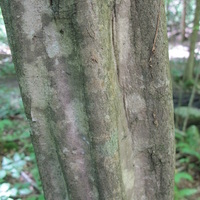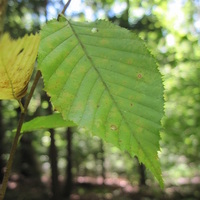American Hornbeam : Appearance
While the hornbeam only reaches a maximum height of 35 feet, it is distinguished by its interesting appearance. The bark of the Hornbeam is smooth and gray and is constructed in ridges or flutes which gives the bark an muscle-like appearance. The trunk often splits near the base, resulting in a wide spreading canopy of about 35 feet in circumference. The leaves of the hornbeam are simple, dark green leaves that grow about four inches long and have serrated edges. In the fall the leaves turn scarlet making the tree an effective, but underutilized, ornamental. George Barrell Emerson, a devoted naturalist and a founder of Harvard’s Arnold Arobretum writes, “The crimson, scarlet, and orange of its autumnal colors, mingling into a rich purplish red, as seen at a distance, make it rank in splendor almost with the tupelo and the scarlet oak. It is easily cultivated, and should have a corner in every collection of trees” (Emerson, 1846). The tree also has catkins, cylindrical flowers that produce pollen for reproduction. The catkin of the American hornbeam is pale yellow or green and female catkins when pollinated can grow to contain 10 – 30 winged seeds. The catkins reach only about an inch and a half in length and form in the spring. Hornbeam nuts are small and remain on the tree until late in the fall.



